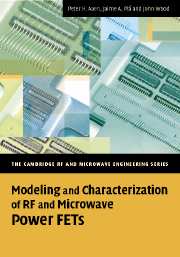Book contents
- Frontmatter
- Contents
- Preface
- Acknowledgments
- 1 RF and Microwave Power Transistors
- 2 Compact Modeling of High-Power FETs
- 3 Electrical Measurement Techniques
- 4 Passive Components: Simulation and Modeling
- 5 Thermal Characterization and Modeling
- 6 Modeling the Active Transistor
- 7 Function Approximation for Compact Modeling
- 8 Model Implementation in CAD Tools
- 9 Model Validation
- About the Authors
- Index
3 - Electrical Measurement Techniques
Published online by Cambridge University Press: 19 August 2009
- Frontmatter
- Contents
- Preface
- Acknowledgments
- 1 RF and Microwave Power Transistors
- 2 Compact Modeling of High-Power FETs
- 3 Electrical Measurement Techniques
- 4 Passive Components: Simulation and Modeling
- 5 Thermal Characterization and Modeling
- 6 Modeling the Active Transistor
- 7 Function Approximation for Compact Modeling
- 8 Model Implementation in CAD Tools
- 9 Model Validation
- About the Authors
- Index
Summary
Introduction
Obtaining precise measurement data at microwave frequencies is a demanding task. Complex equipment and elaborate calibration procedures are needed, and a significant fraction of the time needed to generate a model is spent on the collection of measurement data. Measurement quality and accuracy are paramount, as they are the basis for generation and validation of models.
Historically, significant advances in transistor modeling have coincided with the development of new measurement techniques. The more obvious examples include: the introduction of the vector network analyzer to measure small-signal scattering parameters [1,2]; mechanical and electronic loadpull systems for mapping the small-signal (for example, noise parameters) and the large-signal (power, linearity, and so forth) performance parameters as a function of the impedance presented to the transistor [3]; pulsed DC [4–6] and S-parameter [7, 8] systems used to overcome complex transistor dynamics and dispersive phenomena. More recently, the development of the large-signal vector network analyzer has enabled the characterization of transistors under realistic large-signal modulations [9–11].
In this chapter, we elaborate on general issues related to the measurement environment, including a description of the fixtures used during the model extraction and validation processes. In addition, we shall present a description of the different calibration schemes used during the measurement process followed by an explanation of the de-embedding process. Subsequently, we shall describe measurement techniques that are essential for the generation and validation of high-power transistor models.
- Type
- Chapter
- Information
- Modeling and Characterization of RF and Microwave Power FETs , pp. 71 - 122Publisher: Cambridge University PressPrint publication year: 2007

